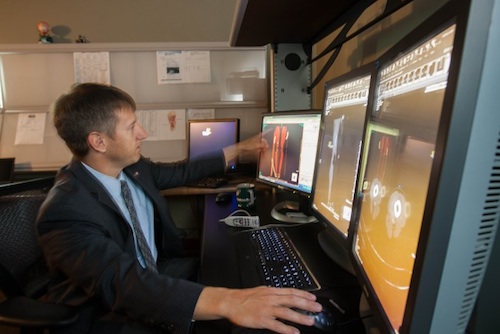Compartment syndrome happens when athletes build up their leg muscles — essentially, because the amount of space within the leg is finite, eventually the muscles push up on blood vessels, which restricts blood flow. Pain follows. Typically, for someone like a triathlete, the easiest way to fix this problem is to simply, well, quit being a triathlete. Intensely competitive people have a problem doing that, obviously, so your other option is surgery — but traditional surgery can involve a six month (or year) recovery time, as well as the other issues with surgery (cost, waking up groggy, rehab, etc.) Scar tissue can also form in a typical surgical procedure.
But now, there’s a different way — and it was developed, in of all places, Casper, Wyoming. Dr. Joseph McGinley developed a 45-minute procedure involving the injection of botox into the affected area and it’s become all the rage for certain types of athletes; 30 percent of his clients are now from outside of Wyoming, often from the east coast and California. He himself says:
“There are a lot of gimmicks in medicine,” McGinley said. “People are skeptical right away when they hear ‘Casper, Wyoming.’ But … patients will do their own research and become convinced this is the way to go.”
Three years into doing this procedure, McGinley has to spend nothing on marketing/advertising his practice. People come to him. Casper is a town of less than 58K people that’s 2.5 hours from Cheyenne (and about 4 hours from Denver).
https://twitter.com/WyomingMedical/status/419855896143880193
This is all perhaps unsurprising, considering that McGinley himself is an avid outdoor athlete: he’s done seven Alcratraz swims, climbed Mount Kilimanjaro, and did the “Cowboy Tough” ride last summer (350 miles across Wyoming).
Here’s a full rundown of his method, which has done wonders for him, his town, his practice, and the athletes involved. He actually developed the process and mechanism not simply via medical understanding, but largely through an understanding of engineering:
“From there, I just put the engineering mechanics together: If she is exercising, she is exerting force and the artery is open, but the vein is now compressed. It’s a pressure mismatch. It’s a flow mismatch, and from an engineering standpoint, there has to be a consequence to that,” McGinley said.
While McGinley has a patent pending on some of the processes here, he is working with doctors at NYU, the Cleveland Clinic, and a facility in Denver to be able to offer the same procedures there.
